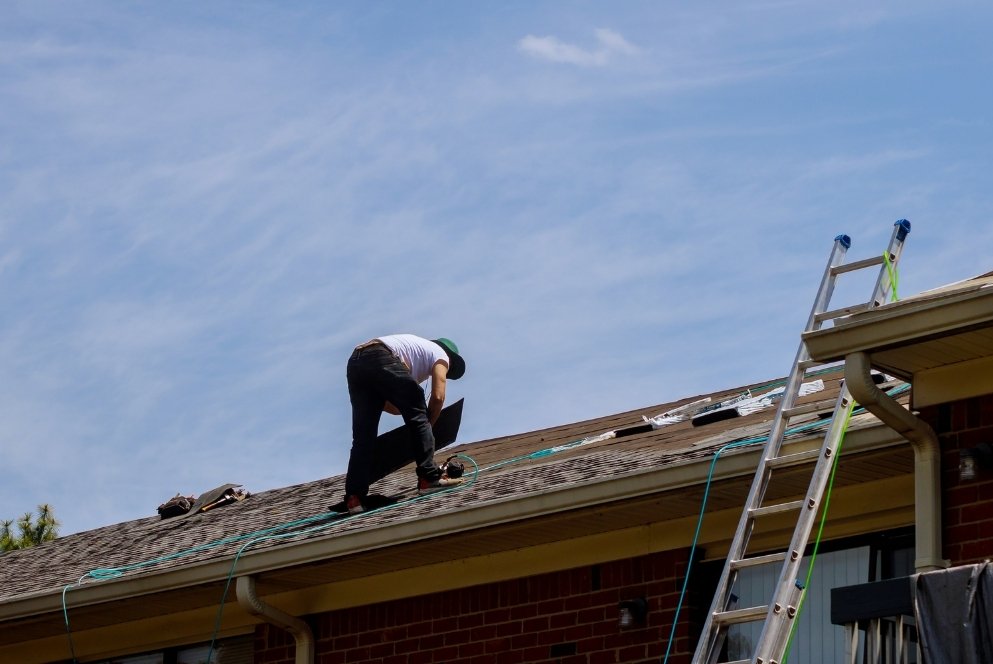Your roof won’t last forever. However, you might not know when this protective barrier should be replaced unless you proactively look for signs of damage and have a comprehensive understanding of what, exactly, should necessitate roof repair. When in doubt, lean on an experienced roofer to perform a truly comprehensive roof inspection on your behalf. Let’s take a look at some common signs that indicate it is time to replace your roof.
Need a Storm Damage Inspection?
Start by Examining the Interior
If your roof is more than ten years old, if a powerful storm recently passed through the area, or if you suspect your roof is damaged, start your analysis from the interior of your home. Head up to the attic or another part of your home, where the inside of the roof can be seen. Bring a flashlight and take a close look for signs of damage. Interior damage in the form of leaks, beams of light, stains, and streaks are clear signs that indicate there is considerable damage that necessitates roof repair or replacement.
Check for Wind Damage on the Roof After Storms
If a storm recently passed through the area, the powerful winds, sleet, and hail might have damaged your roof to the point that it requires replacement. Though fairly new roofs that are properly installed should remain in place during storms, there is always the potential for strong wind and heavy rain to cause damage, especially if your roof is more than a decade old. If the shingles on the roof are curling, broken, or have flown off the roof due to the storm, repair or replacement will be necessary.
Breaks and Cracks are Cause for Concern on Your Roof
If you notice any breaks or cracks along either the exterior or interior of your home, it is an indication that the roof has been compromised. If the cracks and breaks are significant, they will necessitate roof replacement.
Roof Rot
If the roof is rotting, it will likely require replacement. Several damp sections of the roof, areas of mold growth, and even a darker hue on roof beams indicate that the roof is either rotting or suffering from excessive dampness that will undermine its structural integrity. Furthermore, if you spot any part of your roof is dripping water or sagging due to moisture, it is likely rotting. Though it might be possible to simply repair or replace the sections that have been affected by water, a full roof replacement is the only surefire way to guarantee the structure over your head will hold strong. The alternative is to leave the rotting roof in its current condition, allowing additional mold to grow and spread, moving into the ducts, vents, and airways within your living space.
Roof Hail Damage
Hail storms are particularly problematic for roofs as they are powerful, hard, and heavy. If hail strikes your roof, it can puncture or tear your shingles. Sadly, hail also has the potential to knock granules off the roof. When this protective layer is lost, the sun’s UV rays start to destroy the roof, causing more granules to fall, ultimately putting the protective barrier above your head in jeopardy. Even if you can’t see roof damage from ground level after a hailstorm, there might be significant damage observed with an on-roof inspection. When in doubt, have a roofing contractor inspect your roof after a hail or wind storm to determine the true extent of the damage and determine whether a repair is necessary.
Roof Stains and Streaks
Discoloration, streaks, and stains on the roof’s interior are cause for concern. Such discoloration should be closely inspected by a roofing professional to identify the cause. Streaks and stains within the interior walls of the roof often indicate there is a considerable problem, such as a leak that will jeopardize the roof’s functionality in the months and years ahead.
Exposed Nails on a Roof are a Red Flag
Several exposed nails within the roof shingles or in the roof base are a sign that there is cracking or a leak. It is also possible that several exposed nails are a sign the roofers who performed the installation did not sweat the small stuff of the project, ultimately reducing your roof’s quality, durability, and lifespan.
Loose Step Flashing on the Roof
Step flashing is installed on the walls that connect with the roof. The small flashing guides water across the shingle so it can move downhill and ultimately off the roof. If your roof flashing ends up rusting through or if a piece loosens, water will follow, heading into your house. It might be possible to repair loose step flashing, yet a total roof replacement might be the better option.
Roof Leaks
If your roof has one or several leaks, it is a sign that significant repair or total replacement will be necessary. The bottom line is a roof leak puts your home’s structural integrity at risk. Do not delay addressing this urgent problem. The last thing you need is for a roof leak to cause considerable rot, subsequent mold growth, and related health problems such as difficulty breathing.
Roof Age
In general, roofs typically last between 15 and 25 years. However, the material your roof is made of, the quality of the installation, and the frequency of storms ultimately determine its lifespan. As an example, if you have a metal roof, it is likely to last 50+ years. Roofs with asphalt shingles typically last between 15 and 25 years.
Considering all these factors, deciding if you need a new roof is a job best left to professionals. Whether it is just lived out its lifespan and needs replacing or you have storm damage, contact us today to schedule an appointment to have an expert take a look. We can help with filing your insurance claim all the way through to roofing repairs and replacement.
